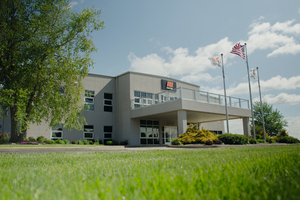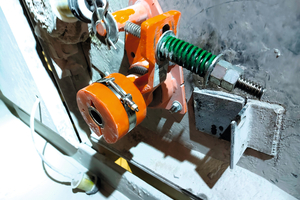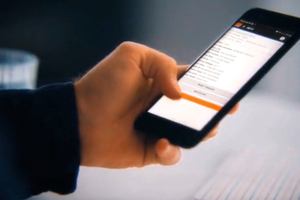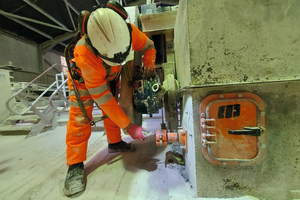Benefits and pitfalls of adopting advanced technologies
The potential for remote monitoring and machine learning to enhance performance in the recycling industry promises impressive time and cost savings. While technologies using remote sensors can help to overcome significant maintenance challenges, their implementation can also create new unforeseen problems.
Martin Engineering has been among the pioneers of technology solutions for materials processing. Among these, over the past decade, the company’s engineers have developed remote monitoring solutions that provide data on the condition and performance of conveyor belt cleaners that virtually eliminate the need for maintenance teams having to physically go to the equipment to perform a manual inspection.
Traditional inspection regimes not only introduce unnecessary operating costs but also create needless exposure to safety risks. That’s why remote monitoring is especially effective, particularly in cases when, for example:
access is difficult and inspection involves complex procedures and supervision,
the operation needs to shut down just to open up and inspect the equipment,
the conveyors are dispersed so most of the inspection is the time taken to go there,
inspecting every location takes days, only to reveal that no maintenance is needed.
The challenge of preventive maintenance
The relentless drive for continual production makes it more likely that preventive maintenance inspections get pushed down the “to do” list, and action only becomes a priority when there’s a problem that needs fixing. Unfortunately, this can mean plants “run to failure” rather than being run to maximise long-term, cost-effective productivity.
Components like conveyor belt cleaners, which may not be seen as critical to productivity compared with other parts of the operation are among the first to be overlooked. As a result, service technicians are often called upon to react to a problem rather than prevent one. Of course, ignoring maintenance for too long is widely known to result in higher costs and more downtime in the long term.
Remote monitoring mechanisms not only reduce labor but curtail unsafe behaviors such as taking shortcuts to access equipment to save time, ignoring inspection schedules and risk assessments, or engaging in quick fixes with inadequate tools rather than planning safe maintenance during designated downtime.
By using cloud-based technology, operators can do real-time, condition-based monitoring and preventive maintenance of components like belt cleaners or air cannons. The data collected from sensors can help to predict when servicing may be required, giving operators enough time to arrange an inspection, order the required parts and book contractors to carry out maintenance during scheduled downtime.
The growth of viable remote monitoring
Martin Engineering’s Center for Innovation, located in Illinois/USA designed and developed the first device for monitoring polyurethane conveyor belt cleaners, N2® Position Indicator (PI). With the goal of making the unit affordable, accessible, reliable and easy to install, the conveyor belt cleaners’ performance and condition information is transmitted via a central “gateway” to the cloud. Data is then clearly presented and easily accessed via a dedicated mobile app or desktop platform.
Martin’s N2® PI is the ideal solution for drastically cutting down on inspection time, and the more difficult and time-consuming the belt cleaners are to inspect, the greater the potential for time saving. Essentially, if you know the know the condition of the belt cleaner blade by using the app, there is no need to go and visually inspect it. Live installations show that PI can reduce inspection time by as much as 90 %, which also means reduced exposure to the safety risks associated with accessing conveyors. Additionally, remote monitoring eliminates the guesswork around belt cleaner servicing – the condition of the blade is based on data driven facts rather than human observation and perception. That opens up the prospect of true preventive maintenance and, over time, predictive maintenance.
Since its introduction, there are now thousands of PI devices installed at more than 40 mineral processing operations worldwide. However while monitoring the performance of the PI the team at Martin Engineering has discovered that it might not be the right fit for some operators. And just like the familiar personal tech we all use every day, remote monitoring can also be the source of some frustrations. Working closely with customers, Martin engineers identified four key areas to consider with the implementation of a remote monitoring system.
1 Does the system address the real problems?
Martin Engineering’s design engineers think a lot about “pain points” – the everyday problems that cause hassle, create risk, slow productivity, waste time and cost money. The company’s core mission of „cleaner, safer and more productive“ operations drives the design and engineering of its extensive catalog of products. During initial research, it was clear that many technological solutions falter because they do not address real problems. In other cases, developers fail to clearly explain to operators how their innovative solution addresses their problems. And perhaps worst of all are those examples where new technology introduces new pain points that have been overlooked during development and testing.
Critical for Martin Enginering’s designers, therefore, is to ensure that new technologies support the identification of Key Performance Indicators (KPIs) to ensure the right pain points are being addressed. Unique to each processing plant, these KPIs focus on production inefficiencies and the operational discrepancies between individual belt conveyors.
For example, the PI system is designed to show if there’s a problem with a belt cleaner blade on each conveyor. For some maintenance managers that’s useful for them to take urgent action. For others it’s just another notification about another task on an already too-long list of jobs (and frankly one that they’re not going to get round to anytime soon). So remote monitoring is only useful if internal maintenance team has the bandwidth to keep up.
In other examples, such as a site where the production team continually conducts walk-rounds and visual inspections of the whole operation, remote monitoring is not valued to the same extent as sites where a walk-round is done infrequently. Data from the sensors is telling them what they already know so having to consult the app is itself a pain point.
2 Does the system deliver useful, actionable data?
In a major materials processing operation, there’s a risk that remote monitoring solutions may lead to data overload. All of us are already inundated with information coming from innumerable sources, and additional data coming from remote monitoring systems competes with emails, messages and endless other notifications. Yet it’s easy to fall into the trap of thinking that having access to lots more information is the goal, rather than the decisions and actions we take based on that information.
No matter how impressive any technology may be, or how interesting remote monitoring metrics may be, data collection alone doesn’t achieve better productivity. The information therefore needs to be helpful, accurate and presented in a way that helps decision-making. Equally, having the wrong KPIs can switch focus away from the desired outcome and skew decision making in a way that is ultimately detrimental to productivity. The Martin OnSite mobile app and dashboard provides a series of clear charts with actionable information that’s automatically analysed, interpreted and presented in a way which makes decisions straightforward.
3 Are operators willing and able to change?
One of the biggest barriers to advancement is the inability or unwillingness to change. This comes in two main forms – business processes and people. Firstly, long-established business processes can be rigid, engendering ways of working that become ingrained over decades. Secondly, people are generally resistant to change in their daily routines, regardless of inefficiency or safety.
So introducing any technology requires change management. The installation and integration of the system must ensure the benefits of the change are well-anticipated and understood by stakeholders, and the new workflows are less onerous than the current regime. For example, workers in mining operations often provide pushback believing that technology could make their jobs redundant. This is not wholly unfounded, after all, on a large-scale processing plant N2® PIs could replace what a typical worker does for up to a day each week.
In some cases, conveyor belt maintenance teams who aren’t aware that sensors are fitted, or aren’t trained how they function, have had negative impacts on monitoring systems because they have failed to reset them correctly. Elsewhere there has been deliberate tampering of monitoring devices, and in one case the workers believed the new tech installations would be used to “spy” of their behaviour, damaging their morale.
So, like all new systems, those involved must be prepared and trained in the right way, including explaining the rationale for installing remote monitoring systems. When people are required to learn something new, without understanding why they are being asked to change, resistance is likely, and failure is probable. Such resistance can also be overcome by ensuring any new technology is easy-to-use, intuitive and even preferrable to (and certainly not worse than) whatever the current procedures are.
4 Is integration into existing systems possible?
The N2® PI is designed to be retrofitted to belt cleaners without any other upgrades to the system. And the system is also scalable across operations of all sizes, types and ages without incurring additional cost. However, there may be numerous physical obstacles ranging from accessibility and available space to legacy steelwork that needs refabricating.
Once the central Gateway is installed and powered, each PI can be fitted and paired in just a few minutes. More importantly, a single Gateway can handle 1000s of PI sensors so expanding the N2® network doesn’t require further investment in the communication infrastructure.
If an operation already has centralized remote monitoring for other components, N2® data can integrate with existing systems although it may require additional work to ensure compatibility. To avoid data overload, it is recommended to begin with simple core actionable KPIs such as status and wear times, then expand from there as required.
The key to success
After spending around five years developing remote monitoring for conveyor belt cleaners, Martin Engineering formally launched the technology just before the global covid pandemic in 2020. Working hand-in-glove with customers’ production and maintenance teams, Martin® Service Technicians listened, resolved early technical challenges and reported issues. As a result, Martin has gone on to develop two further N2 sensors for conveyor products, which work with the same Gateway, and are expected to launch a new flow aid sensor in 2025.
As with all things, a pragmatic and balanced perspective is required when embracing new technologies. Martin is dedicated to helping customers accomplish their safety and efficiency goals, so the consultation and inspection of operations for viability, followed by a proper introduction and phased integration is recommended. To achieve the desired productivity improvement, it is imperative to understand the potential pitfalls that accompany change. Most importantly, having the right conversations, listening to understand the true pain points, embracing the challenge and working together are critical to deliver tangible results.





